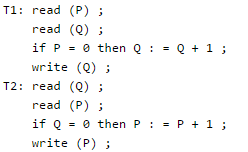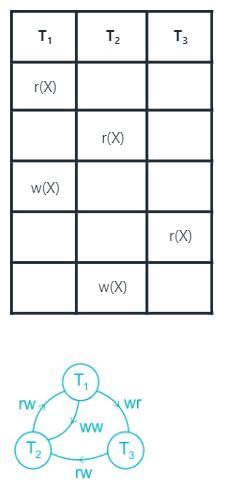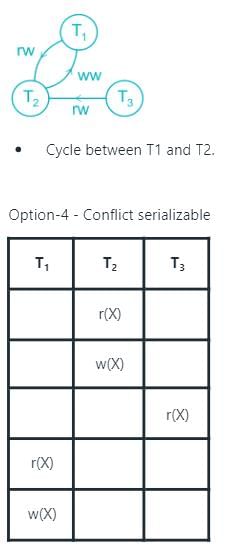Test: Transactions & Concurrency Control- 1 - Computer Science Engineering (CSE) MCQ
20 Questions MCQ Test - Test: Transactions & Concurrency Control- 1
Consider the following transactions with data items P and Q initialized to zero:

Any non-serial interleaving of T1 and T2 for concurrent execution leads to
Which of the following concurrency control protocols ensure both conflict serialzability and freedom from deadlock?
I. 2-phase locking
II. Time-stamp ordering
I. 2-phase locking
II. Time-stamp ordering
Consider the following schedule for transactions T1, T2 and T3:

Q. Which one of the schedules below is the correct serialization of the above?
Consider the following four schedules due to three transactions (indicated by the subscript) using read and write on a data item x, denoted by r(x) and w(x) respectively. Which one of them is conflict serializable.
Consider the following schedule S of transactions T1, T2, T3, T4:
Q. Which one of the following statements is CORRECT?
Consider the transactions T1, T2, and T3 and the schedules S1 and S2 given below.
Q. Which one of the following statements about the schedules is TRUE?
Consider the following log sequence of two transactions on a bank account, with initial balance 12000, that transfer 2000 to a mortgage payment and then apply a 5% interest.
1. T1 start
2. T1 B old=12000 new=10000
3. T1 M old=0 new=2000
4. T1 commit
5. T2 start
6. T2 B old=10000 new=10500
7. T2 commit
Q. Suppose the database system cra shes just before log record 7 is written. When the system is restarted, which one statement is true of the recovery procedure?
Which of the following scenarios may lead to an irrecoverable error in a database system ?
Consider three data items D1, D2 and D3 and the following execution schedule of transactions T1, T2 and T3. In the diagram, R(D) and W(D) denote the actions reading and writing the data item D respectively.
Q. Which of the following statements is correct?
Consider the following transaction involving two bank accounts x and y.
read(x); x := x – 50; write(x); read(y); y := y + 50; write(y)
The constraint that the sum of the accounts x and y should remain constant is that of
Consider a simple checkpointing protocol and the following set of operations in the log.
(start, T4); (write, T4, y, 2, 3); (start, T1); (commit, T4); (write, T1, z, 5, 7);
(checkpoint);
(start, T2); (write, T2, x, 1, 9); (commit, T2); (start, T3); (write, T3, z, 7, 2);
Q. If a crash happens now and the system tries to recover using both undo and redo operations, what are the contents of the undo list and the redo list
Consider the following partial Schedule S involving two transactions T1 and T2. Only the read and the write operations have been shown. The read operation on data item P is denoted by read(P) and the write operation on data item P is denoted by write(P).
Q. Suppose that the transaction T1 fails immediately after time instance 9. Which one of the following statements is correct?
Which level of locking provides the highest degree of concurrency in a relational data base?
Which one of the following is NOT a part of the ACID properties of database transactions?
Consider the following two phase locking protocol. Suppose a transaction T accesses (for read or write operations), a certain set of objects {O1,...,Ok}. This is done in the following manner:
Step 1. T acquires exclusive locks to O1, . . . , Ok in increasing order of their addresses.
Step 2. The required operations are performed.
Step 3. All locks are released. This protocol will
Suppose a database schedule S involves transactions T1, ....Tn. Construct the precedence graph of S with vertices representing the transactions and edges representing the conflicts. If S is serializable, which one of the following orderings of the vertices of the precedence graph is guaranteed to yield a serial schedule?
Consider the following database schedule with two transactions, T1 and T2.
S = r2(X); r1(X); r2(Y); w1(X); r1(Y); w2(X); a1; a2;
where ri(Z) denotes a read operation by transaction Ti on a variable Z, wi(Z) denotes a write operation by Ti on a variable Z and ai denotes an abort by transaction Ti . Which one of the following statements about the above schedule is TRUE?
Consider the following three schedules of transactions T1, T2 and T3. [Notation: In the following NYO represents the action Y (R for read, W for write) performed by transaction N on object O.]
(S1) 2RA 2WA 3RC 2WB 3WA 3WC 1RA 1RB 1WA 1WB
(S2) 3RC 2RA 2WA 2WB 3WA 1RA 1RB 1WA 1WB 3WC
(S3) 2RA 3RC 3WA 2WA 2WB 3WC 1RA 1RB 1WA 1WB
Q. Which of the following statements is TRUE?
Which of the following statement is/are incorrect?
A: A schedule following strict two phase locking protocol is conflict serializable as well as recoverable.
B: Checkpoint in schedules are inserted to ensure recoverability.
Which of the following concurrency control protocols ensure both conflict serialzability and freedom from deadlock?
I. 2-phase locking
II. Time-stamp ordering
























